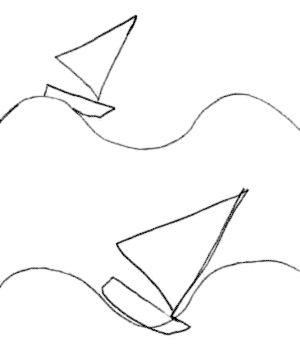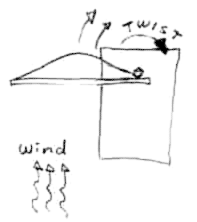Control Problems In Heavy Winds
Problem 1
Can't go to windward in heavy winds
What happens is that the sails produce a certain amount of lifting force. That force increases with the wind speed in an uneven manner, so that they lift the best in a certain wind speed, and then the more wind you have, you only get a little bit more lift. The hull freeboard (the hull part above the water) produces drag as the wind blows on it. The drag seems to increase steadily as the wind speed increases. So when the wind isn't blowing that hard, your lift can easily overcome the drag. As the wind picks up, you get more and more drag, but not so much more lift, and eventually the lift power of your sails can not overcome the drag of the hull, and you loose your ability to sail to windward.
If you built a hull configuration with a cabin, it will have an even larger amount of drag -- so that is one of the compromises you have to think about. With this problem in mind, you might think about building a hull that is only 10" high (the minimum class legal size), so you can have the minimum amount of freeboard, but this hull configuration has it's problems too. In choppy water or when coming about quickly, you can easily dig the bow into the water which greatly slows it down, or can swamp the boat.
Problem 2
Digging The Bow
(& Submarining)
Digging the bow is when the bow is pushed down into the water, so much that the water starts to come over the bow deck to various amounts. Sometimes you can see just a little bit of water and spray flying up from the bow, and at the other end of the spectrum the entire boat can dive underwater.

There are 2 main scenarios where this happen:
Suddenly Turn Down Wind- When you are beating hard to windward, and then suddenly turn to go down wind (like when you are rounding the windward mark). Your body is positioned more in the middle of the boat and hiking out a bit. When you turn to go down wind, the sail & mast act like a big lever arm, the mast partner is the pivot point, and the boat is being twisted around it. This twisting motion lifts the stern in the air, and pushes the bow down into the water - also called a pitch polling effect. The taller your sail is, the more you will have this effect.
There are a couple of things you can do to counteract this. First is to move up onto your stern deck, so your weight is further aft. Or you can go to a further extreme (like I do) and kneel so you are leaning aft over the stern, facing backwards. After the boat gets going, the twisting forward motion will lessen and you can adjust your weight accordingly. Another thing you can do, if your sail can rotate to completely forward, you can let it out almost all the way and then gradually pull it back in as the boat speed increases.
Other sailboats experience this same effect, it is just usually not as apparent becuase they have a much more conservative sail area to hull size ratio. Some sailboats have such a pitch polling effect, that when tripped up, they can literally flip forward and end up capsized - this happens in Hobie catamarans, International 14's and others.
Bury Into Wave - When sailing in choppy water, or around power boats that throw off big wake, when sailing down the slope of one wave, you end up buring the bow into the next wave, and possibly even submarining under it (the whole hull goes under water). This is a common effect with all sailboats, but with longer sailboats w/pointy bows, only the bow will dig in the water and it will pop back up before the rest of the hull has had a chance to slide under the wave as well. To avoid this, you need to avoid sailing closer than 45 degrees to the face of waves. If you have to tack, time it so that you turn mostly on the upward side of a wave, and by the time you reach the crest, you are sailing the other way.

Or if you have a self draining design, you can just plow under the waves and keep going. I completely submarined BucketEars once, I was sailing in a protected area with some heavy winds. Just as I sailed beyond the protected zone, I went up a wave, down the other side and completely under the next wave. Because I had all that speed, the hull when completely under and came up the other side. She didn't capsize, and because I had rebuilt her as a donut configuration with only a small foot well, the hull popped back up. I heeled over a bit to dump some of the water out, but other than that went on sailing just fine.
Another fun thing I enjoy is taking a board boat like my Holder 12 out into big water to plow thru the waves. Because they have such long narrow bows, and they quickly self drain, they can ride the waves like a rocking horse and slice thru the ones that they catch.
Problem 3
Rudder Stops Working, Can't Steer
Further description of the problem: When sailing in light winds (like up to 15 mph) the boat handles just fine, and is easy to control. After the wind gets stronger, you try to steer and she won't respond to the tiller, and will continue on a straight line. Also related is a certain wind speed when you can go to windward just fine, but going down wind you can't go straight down wind -- you can only go about 30 degrees off directly down wind, in the opposite side that you have your sail. What is happening here is that we have very short boats, and most of them have the leeboard mounted about half way back, so there is only a distance of 4' between the leeboard and the rudder -- that means we don't have much of a lever arm (rudder) distance to work against our pivot point (leeboard). At the same time, we put a LARGE amount of sail up, like around 60+ sqft, most 8' boats have a much smaller amount of sail, like 30-40 sqft. So this large sail we use produces a LOT of lift in the heavier air, and at a certain point will overpower your controls.

There are various solutions to this problem.
Release Sail - You can let go of your sail so that it rotates forward and stops driving your hull, drop off the speed, and then change course. Pull the sail back in and sometimes it will continue in that direction.
Jibe Down Wind - Sometimes you can't go directly down wind, but you can go at an angle to down wind, so you can jibe back and forth as you work your way back down wind. Sort of like tacking in reverse.
Make a bigger rudder - If you are going to be in heavy winds all the time, a bigger rudder might be what you need.
Bow Skeg (or bow centerboard) - The Dovekie has a similar problem most of the time, they fixed it by adding a small drop down board at the bow. The greater distance bewteen it and the rudder makes it more effective, even though it is so small.
|

